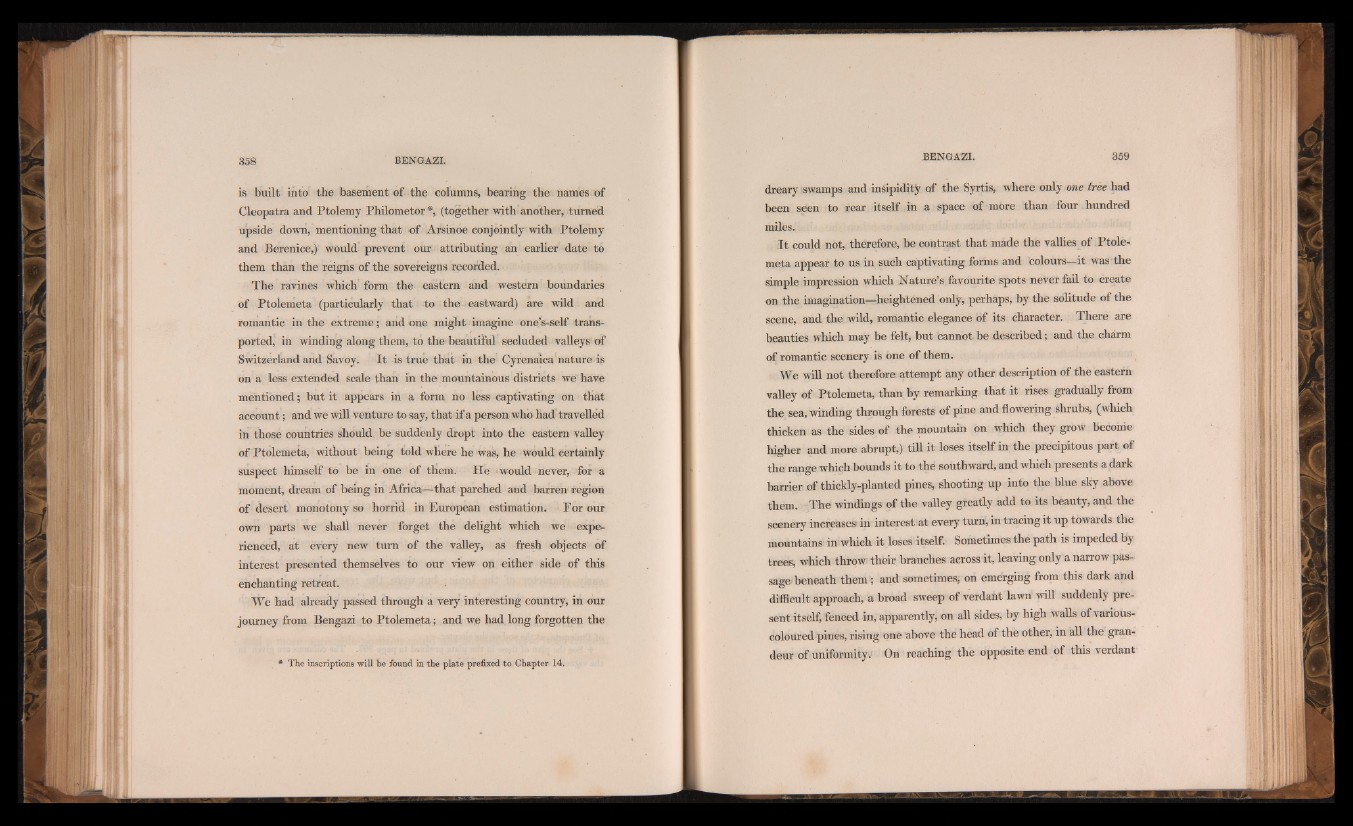
is built into the basement of the columns, bearing the names of
Cleopatra and Ptolemy Philometor *, (together with another, turned
upside down, mentioning that of Arsinoe conjointly with Ptolemy
and Berenice,) would prevent our attributing an earlier date to
them than the reigns of the sovereigns recorded.
The ravines which form the eastern and western boundaries
of Ptoiemeta (particularly that to the eastward) are wild and
romantic in the extreme; and one might imagine one’s-self transported,
in winding along them, to the1 beautiful secluded valleys of
Switzerland and Savoy. I t is true that in the Cyrenaica‘nature is
on a less extended scale than in the mountainous districts we” have
mentioned; but it appears in a form no less captivating on tliat
account; and we will venture to say, that if a person who had travelled
in those countries should be suddenly dropt into the eastern valley
of Ptoiemeta, without being told where he was, he would certainly
suspect himself to be in one of them. He would never, for a
moment, dream of being in Africa—that parched and barren- region
of desert monotony so horrid in European estimation. For our
own parts we shall never forget the delight which we experienced,
at every new turn of the valley, as fresh objects of
interest presented themselves to our view on either side of this
enchanting retreat.
We had already passed through a very interesting country, in our
journey from Bengazi to Ptoiemeta; and we had long forgotten the
* The inscriptions will be ibund in the plate prefixed to Chapter 14.
dreary swamps and insipidity of the Syrtis, where only one tree had
been seen to rear itself in a space of more than four , hundred
miles.
I t could not, therefore, be contrast that made the vallies of Ptoiemeta
appear to us in such captivating forms and colours—it was the
simple impression which Nature’s favourite spots never fail to create
on the imagination—heightened only, perhaps, by the solitude of the
scene, and the wild, romahtic elegance of its character. There are
beauties which may be felt, but cannot be described; and the charm
of romantic scenery is one of them.
We will not therefore attempt any other description of the eastern
valley of Ptoiemeta, than by remarking that it rises gradually from
the sea, winding through forests of pine and flowering shrubs, (which
thicken as the sides, of the mountain on which they grow become
higher and more abrupt,) till it loses itself in the precipitous part of
the range which bounds it to the southward, and which presents a dark
barrier of thickly-planted pines, shooting up into the blue sky above
them. The windings of the valley greatly add to its beauty, and the
scenery increases1 in interest at e v e r y turn, in tracing it up towards the
mountains* in which it loses itself. Sometimes the path is impeded by
trees, which throw their branches aeross it, leaving only a narrow passage
beneath them *; and sometimes, on emerging from this dark and
difficult approach, a broad sweep of verdant lawn will suddenly present
itself, fenced in, apparently, on all sides, by high walls of various-
coloured pines, rising one above the head of the other, in all the grandeur
of uniformity .* On reaching the opposite end of this verdant